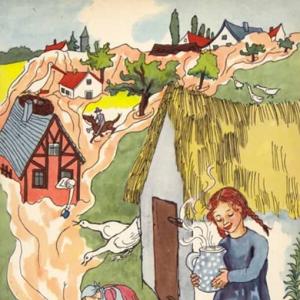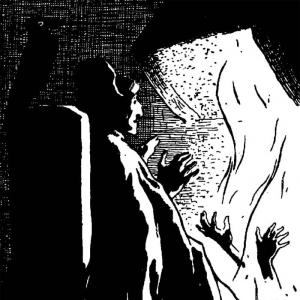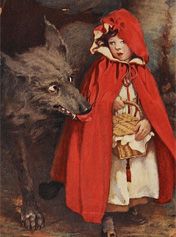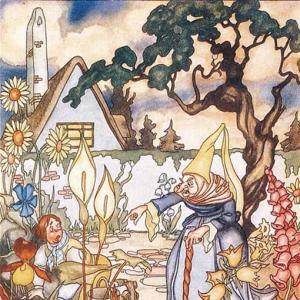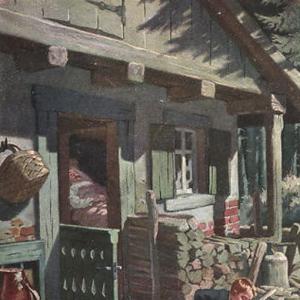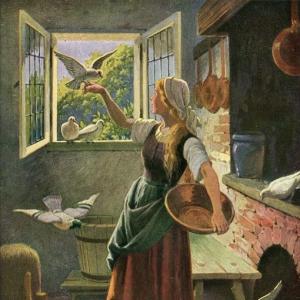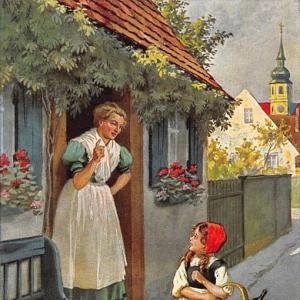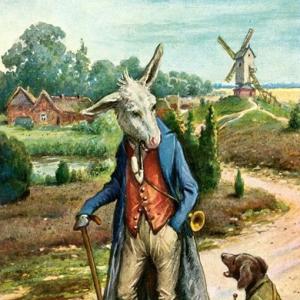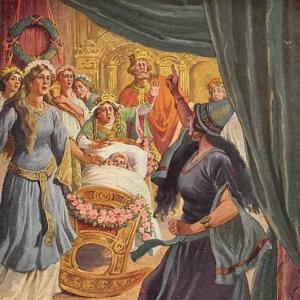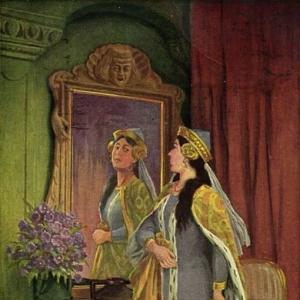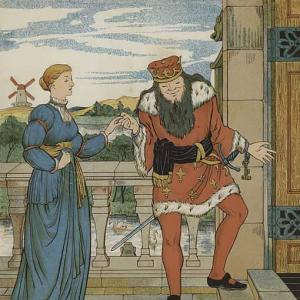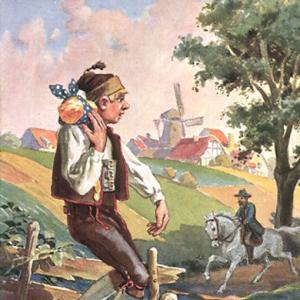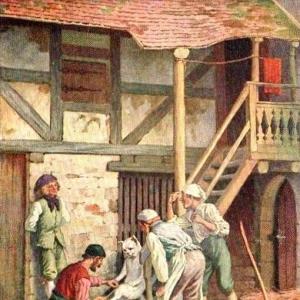Reading time for children: 5 min
A peasant had a faithful horse which had grown old and could do no more work, so his master would no longer give him anything to eat and said, „I can certainly make no more use of thee, but still I mean well by thee. If thou provest thyself still strong enough to bring me a lion here, I will maintain thee, but now take thyself away out of my stable,“ and with that he chased him into the open country. The horse was sad, and went to the forest to seek a little protection there from the weather. Then the fox met him and said, „Why dost thou hang thy head so, and go about all alone?“ – „Alas,“ replied the horse, „avarice and fidelity do not dwell together in one house. My master has forgotten what services I have performed for him for so many years, and because I can no longer plough well, he will give me no more food, and has driven me out.“ – „Without giving thee a chance?“ asked the fox. „The chance was a bad one. He said, if I were still strong enough to bring him a lion, he would keep me, but he well knows that I cannot do that.“ The fox said, „I will help thee, just lay thyself down, stretch thyself out, as if thou wert dead, and do not stir.“ The horse did as the fox desired, and the fox went to the lion, who had his den not far off, and said, „A dead horse is lying outside there, just come with me, thou canst have a rich meal.“ The lion went with him, and when they were both standing by the horse the fox said, „After all, it is not very comfortable for thee here I tell thee what I will fasten it to thee by the tail, and then thou canst drag it into thy cave, and devour it in peace.“
This advice pleased the lion: he lay down, and in order that the fox might tie the horse fast to him, he kept quite quiet. But the fox tied the lion’s legs together with the horse’s tail, and twisted and fastened all so well and so strongly that no strength could break it. When he had finished his work, he tapped the horse on the shoulder and said, „Pull, white horse, pull.“ Then up sprang the horse at once, and drew the lion away with him. The lion began to roar so that all the birds in the forest flew out in terror, but the horse let him roar, and drew him and dragged him over the country to his master’s door. When the master saw the lion, he was of a better mind, and said to the horse, „Thou shalt stay with me and fare well,“ and he gave him plenty to eat until he died.
 Learn languages. Double-tap on a word.Learn languages in context with Childstories.org and Deepl.com.
Learn languages. Double-tap on a word.Learn languages in context with Childstories.org and Deepl.com.Backgrounds
Interpretations
Adaptions
Summary
Linguistics
„The Fox and the Horse“ is a classic fairy tale collected by the Brothers Grimm, two German scholars named Jacob and Wilhelm Grimm. The Brothers Grimm are best known for their compilation of German and European folktales in their famous work „Grimms‘ Fairy Tales“ or „Children’s and Household Tales,“ first published in 1812. Their collection contains over 200 stories, including well-known tales such as „Cinderella,“ „Snow White,“ „Hansel and Gretel,“ and „Rapunzel.“
The Brothers Grimm collected these tales as part of a broader project to preserve the oral storytelling traditions of Germany and Europe. Many of the stories they gathered had been passed down through generations, reflecting the cultural values and beliefs of the people. The tales often include elements of magic, fantastical creatures, and moral lessons, making them both entertaining and educational.
„The Fox and the Horse“ is a lesser-known tale from the Grimms‘ collection, but it shares the same themes and motifs as many other popular stories in the collection. The story highlights the importance of friendship, loyalty, resourcefulness, and the consequences of greed and ingratitude. Like many other fairy tales, the story offers valuable insights and lessons that remain relevant to modern readers.
„The Fox and the Horse“ can be interpreted in several ways, offering valuable lessons and insights:
The value of true friendship and loyalty: The horse and the fox form an unexpected alliance, and their friendship helps the horse overcome his predicament. The fox’s loyalty and willingness to help the horse demonstrate the importance of supporting one another in times of need.
The danger of greed and ingratitude: The horse’s master is depicted as a greedy and ungrateful individual who is willing to cast aside a loyal servant because of his inability to work. This serves as a cautionary tale about the negative consequences of valuing material gain over loyalty and gratitude.
The power of resourcefulness and intelligence: The fox uses his cunning and resourcefulness to outwit the lion, a much stronger and fiercer animal. This illustrates that intelligence and creative thinking can often be more valuable than physical strength in overcoming challenges.
The importance of second chances: The horse’s master ultimately changes his mind and decides to care for the horse after witnessing the impressive feat of capturing the lion. This demonstrates the importance of giving second chances and recognizing the potential for redemption and growth.
The consequences of underestimating others: Both the master and the lion underestimate the abilities of the horse and the fox. The master dismisses the horse’s worth due to his age, and the lion falls into the fox’s trap, believing he is superior. This highlights the importance of not underestimating others based on appearances or preconceived notions.
„The Fox and the Horse“ is a classic fairy tale from Brothers Grimm that has been adapted and retold in various forms over the years. Here are some notable adaptations:
Disney’s „The Fox and the Hound“ (1981): This animated film is loosely based on the Brothers Grimm’s tale and tells the story of a young fox and a hunting dog who become unlikely friends despite their natural instincts.
„The Fox and the Horse“ by Rainbow Rowell (2020): This children’s book reimagines the story with a positive twist, showing how the fox and the horse learn to work together and become true friends.
„The Horse and the Fox“ by Gail Carson Levine (2015): This book is a retelling of the story from the horse’s perspective, giving readers a deeper insight into his thoughts and feelings.
„The Cunning Little Vixen“ by Leoš Janáček (1924): This opera is based on a Czech comic strip that was inspired by the Brothers Grimm’s tale, and features a clever vixen who outwits the other animals in the forest.
„The Fox and the Horse“ by Paul Galdone (1971): This illustrated children’s book stays true to the original story, but updates the language and style for modern readers.
Overall, „The Fox and the Horse“ has inspired a wide range of adaptations and retellings, showcasing the enduring appeal and relevance of this classic fairy tale.
„The Fox and the Horse“ is a fairy tale by the Brothers Grimm about a faithful old horse who is cast out by his master when he is no longer able to work. Feeling dejected, the horse wanders into the forest where he encounters a clever fox. The horse tells the fox about his master’s ultimatum: if he can bring a lion to him, he will be allowed to stay and be cared for. The fox agrees to help the horse in exchange for protection.
The fox devises a plan and instructs the horse to lie down as if dead. He then leads the lion to the seemingly lifeless horse, suggesting that the lion can enjoy an easy meal. The lion agrees, but the fox suggests tying the horse to the lion’s tail to make it easier for the lion to drag the horse back to his den. The lion complies, but the fox cunningly ties the lion’s legs together instead, making it impossible for the lion to escape.
Once the trap is set, the fox taps the horse, signaling him to get up and start pulling. The horse, now in control, drags the lion back to his master’s house. The lion’s roars terrify the birds in the forest, but the horse continues to pull him to his destination. Upon seeing the captured lion, the master changes his mind and allows the horse to stay with him, promising to care for him until the end of his days.
The Brothers Grimm fairy tale „The Fox and the Horse“ offers rich material for linguistic and thematic analysis. This story, like many fairy tales, contains layered meanings and provides insights into human behavior and societal norms through its use of language and narrative elements. Below is an analysis focusing on the linguistic and thematic aspects of the tale.
Dialogue and Formality:
The dialogue in the story is presented in a formal and archaic manner, using „thee“ and „thou“ which are old-fashioned forms of address. This not only reflects the time period in which the Grimms were writing but also lends the narrative a timeless quality.
Use of Direct Speech:
Direct speech is prominently used for interaction between characters, which brings the characters to life and allows readers to understand their personalities and motivations. This also emphasizes the oral tradition of storytelling, characteristic of fairy tales.
Repetition:
Repetition is used to emphasize certain points, such as the fox’s instructions to the horse and the recounting of the horse’s situation. This reinforces the key elements of the plot and helps the audience remember crucial parts of the story.
Descriptive Language:
Descriptive language is sparingly used but effectively conveys the emotions of the characters. For example, phrases like „hang thy head“ and „my master has forgotten“ express the horse’s sadness and sense of betrayal succinctly.
Thematic Analysis
Ingenuity and Wit:
The fox represents cunning and resourcefulness—a common trope in fairy tales. The fox’s quick thinking and clever plan to outsmart the lion exemplify how intelligence can triumph over brute strength.
Loyalty and Betrayal:
The story contrasts loyalty with betrayal. The horse represents loyalty, having faithfully served his master for years, while the master represents betrayal, discarding the horse when he is no longer useful. The ultimate reversal of fortune for the horse highlights the theme of justice.
Master-Servant Relationship:
The tale critiques the master-servant relationship, showing the master’s lack of gratitude and compassion. The master’s initial decision to abandon the horse due to its age is challenged by the fox’s intervention, leading to a reevaluation of worth and loyalty.
Social Commentary:
The phrase „avarice and fidelity do not dwell together in one house“ captures a moral lesson about greed and loyalty often found in folklore. It comments on the human tendency to overlook past loyalty due to present incapabilities or perceived lack of worth.
Triumph of the Underdog:
The story is a classic ‚triumph of the underdog‘ narrative. The horse, initially in a hopeless situation, uses the fox’s cleverness to turn the situation around, securing his future and challenging the master’s earlier judgment.
In conclusion, „The Fox and the Horse“ utilizes classic fairy tale elements such as cleverness, loyalty, and a moral lesson, presented through formal, direct dialogue, and sparse yet effective descriptive language. The narrative not only entertains but also offers timeless reflections on human nature and social structures.
Information for scientific analysis
Fairy tale statistics | Value |
|---|---|
| Number | KHM 132 |
| Aarne-Thompson-Uther-Index | ATU Typ 47A |
| Translations | DE, EN, DA, ES, PT, IT, JA, NL, PL, RO, RU, TR, VI, ZH |
| Readability Index by Björnsson | 33.2 |
| Flesch-Reading-Ease Index | 80.2 |
| Flesch–Kincaid Grade-Level | 8.4 |
| Gunning Fog Index | 11 |
| Coleman–Liau Index | 6.5 |
| SMOG Index | 7.6 |
| Automated Readability Index | 9.1 |
| Character Count | 2.406 |
| Letter Count | 1.821 |
| Sentence Count | 19 |
| Word Count | 481 |
| Average Words per Sentence | 25,32 |
| Words with more than 6 letters | 38 |
| Percentage of long words | 7.9% |
| Number of Syllables | 574 |
| Average Syllables per Word | 1,19 |
| Words with three Syllables | 11 |
| Percentage Words with three Syllables | 2.3% |

